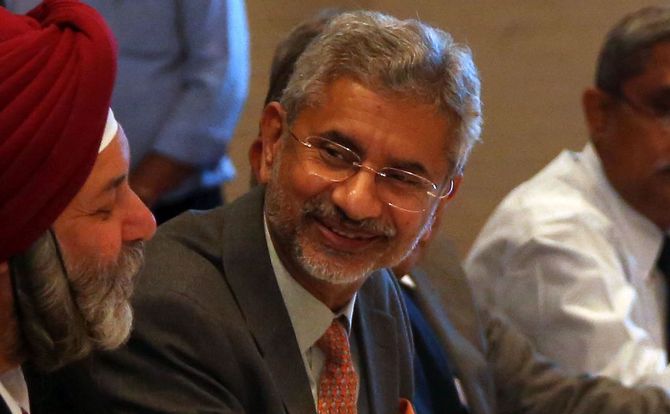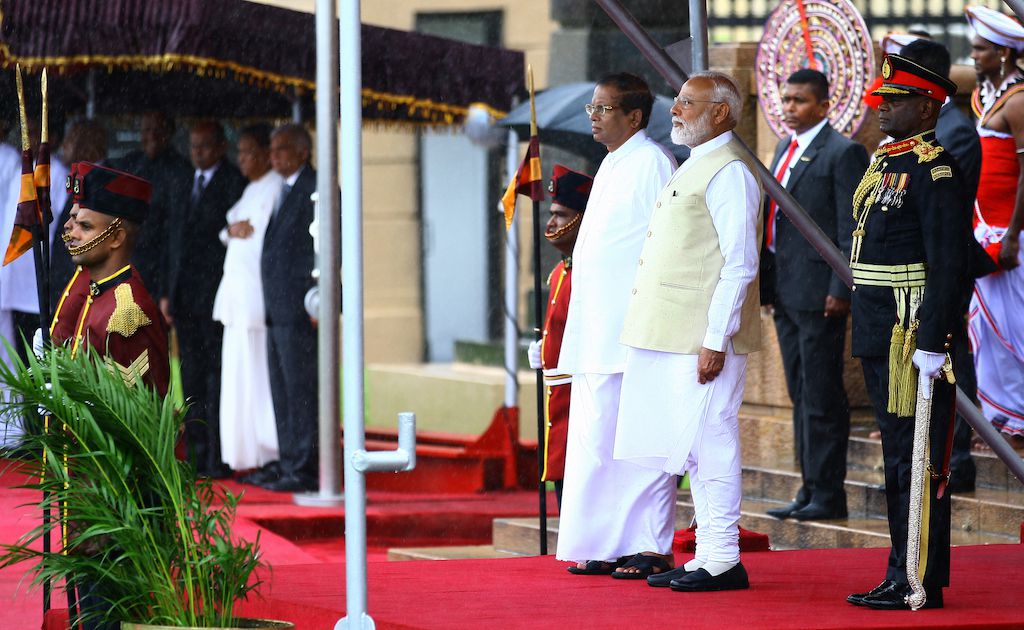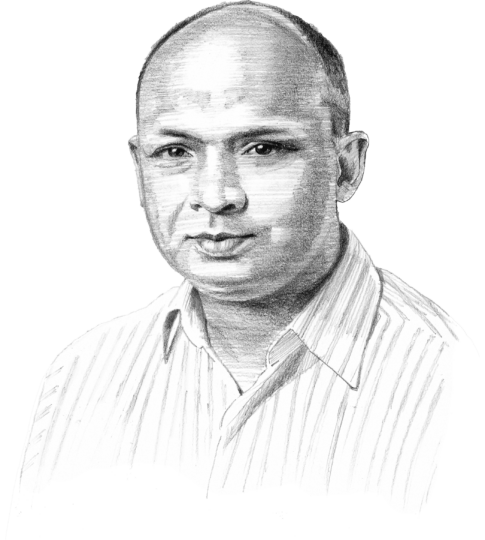Foreign policy during Modi’s second term
Indian Prime Minister currently enjoys high levels of trust among world leaders. He wants to make the most of this advantageous situation to boost India’s foreign policy by simultaneously engaging with the U.S., China, and other strategic geopolitical partners, in addition to fostering better relations with smaller South Asian neighbors.

In a nutshell
- Prime Minister Modi hopes to engage with multiple centers of power during his second term
- New Delhi wants closer ties with the U.S. despite trade issues
- Conflict in the Persian Gulf or recession would compromise policy goals
In his second term as prime minister, Narendra Modi remains committed to leveraging India’s global position to promote the economy. The budget announced last month assumes a large inflow of foreign capital to sustain growth rates and a relatively benign external environment – as shown by a 2 percent cut in defense spending.
Mr. Modi’s office has already outlined the three principles underlying its foreign policy: a slow but certain strategic drift toward the United States; cordial engagement – to some degree – with other centers of power including China and Russia; and economic integration of smaller South Asian states with India. The new foreign minister, Subrahmanyam Jaishankar, noted that the overall plan is to take advantage of the fact that “a lot of countries are taking long-term positions on India.”
United States
The government’s first challenge is to stabilize its relationship with the U.S. There is a strong consensus in Washington, both in the foreign policy establishment and in Congress, on the need for strong ties with New Delhi. President Donald Trump, who sees parallels between Mr. Modi’s electoral success and his own, is also positively disposed toward India. The latter sees the U.S. as an indispensable ally – indeed, India’s largest economic partner if one takes into account investments, remittances and trade.
Indian-Americans, the wealthiest ethnic group in the U.S., also cement the relationship. New Delhi’s closest overseas partners – Japan, Israel and the United Arab Emirates – are in alliances with the U.S. Finally, China is perceived as a long-term strategic challenge, whereas the U.S. is seen as the only country with the ability to balance the geopolitical situation.
The government’s first challenge is to stabilize its relationship with the U.S.
However, Mr. Trump takes a harsh view of India’s protectionist trade policies and its roughly $18 billion trade surplus with the U.S. Longstanding trade disputes came to a head in the past few months, resulting in tit-for-tat tariffs. The issue is now the primary diplomatic challenge of the new government, although it does not compare in scale to the U.S.-China trade conflict. Tariffs have been limited to a few hundred million dollars, and U.S. and Indian diplomats privately say they have orders to ensure this does not disrupt strategic relations.
President Trump has repeatedly ranted against India’s high tariffs on Harley-Davidson motorcycles. Baffled Indian officials pointed out that Harley-Davidson manufactures motorcycles locally and uses India as an export hub. There are select tariffs on motorcycles over 1000 cc but, as a U.S. official admitted, “You imported 84 of those motorcycles last year. Lower tariffs won’t make a difference.” New Delhi hopes the matter will be solved in a few weeks so that the two sides can move forward with agreements designed to further integrate their military forces.
Multialignment
Mr. Modi’s office believes it must continue to work with countries like China, Russia and even Iran. Mr. Jaishankar explained in an interview that “in a world of multiple centers of power, if you decide to not engage with any of them, you weaken your hand.” Senior Indian diplomats have begun unofficially labeling this “multialignment.” They argue that India has the diplomatic leeway to work with multiple players in different parts of the world, picking and choosing depending on specific policy interests. This is partly due to foreign governments’ belief that Prime Minister Modi is more capable of delivering on his promises than many other leaders.
Multialignment is most evident in Sino-Indian relations.
Multialignment is most evident in Sino-Indian relations. Beijing wants to continue the “spirit of Wuhan” – a reference to the truce agreed upon by Mr. Modi and Chinese President Xi Jinping in April last year. India goes along, assuming China is conciliatory because of its problems with the U.S. The breathing space created allows India to contain its defense spending and put pressure on rival Pakistan.
In Western Asia, New Delhi juggles a set of bilateral relations that include the United Arab Emirates, Saudi Arabia, Israel and Iran. India also declined to join the U.S. when the latter pulled out of the Paris Agreement on climate change. Furthermore, it recently agreed to buy the Russian S-400 air defense system despite protests from Washington. From an Indian perspective, the few billion dollars spent on the purchase were a small price to pay to save a flagging relationship with Russia.
Neighbors
Prime Minister Modi underlined the importance of India’s smaller neighbors by inviting the heads of the Bay of Bengal Initiative Multi-Sectoral Technical and Economic Cooperation (BIMSTEC) countries to his inauguration. BIMSTEC, a formerly moribund trade body, is now being revived by India. The first bilateral state visit of Mr. Modi’s second term was the Maldives – a reward for recently tossing out a pro-Chinese regime.

Foreign Minister Jaishankar said that linking South Asia, physically and otherwise, “will be a priority for the next five years.” India has pursued this policy in the past, albeit with limited success. Today it is much better positioned to persuade South Asian countries that close ties are in their own best interests. Japan has financed ports and other infrastructure in countries like Bangladesh and Sri Lanka. Mr. Jaishankar admits India has struggled with project execution. “We have spent the last few years studying these projects, relooking at who we should be partnering.” The government now believes “the undergrowth has been cleared.”
Scenarios
India finds itself in a favorable foreign policy position. The neighborhood is geopolitically stable despite destabilizing global trends. New Delhi expects to solve its trade problems with Washington in a few weeks, after which it will seek to leverage technological disputes between the U.S. and China to attract investment and increase its options in critical areas such as 5G telecom infrastructure. Knowing that China mainly fears being contained by a coalition of Asian states, at the recent G20 summit India emphasized that the “Indo-Pacific” is “for something – not against somebody.” An October summit with President Xi is already scheduled.
India has also been able to line up hundreds of billions of dollars in investment from nontraditional sources of capital such as the Persian Gulf emirates, Southeast Asia and countries like Canada and Norway. Prime Minister Modi recognizes that a stable external environment is crucial to sustaining and expanding these new economic relationships.
There are three main external threats to Mr. Modi’s plans at the present – and only one of these threats can be influenced. The first and worst danger is a conflict in the Persian Gulf that would pit Iran against the U.S. and its allies. This would put pay to many of India’s present hopes, both by disrupting new investments but also by driving up oil prices. India is highly dependent on exports of oil and gas from the Gulf. The second threat is a further escalation of the U.S.-China trade dispute. India has mildly benefited from this economic confrontation, but if this conflict were to expand into a currency war or drive the global economy into recession, no major economy would avoid collateral damage.
Finally, tensions created by February’s limited military confrontation with Pakistan have yet to fully dissipate. Pakistan, hobbled by major economic problems, has signaled a desire for talks, but India has put down stiff preconditions. New Delhi believes Islamabad will unavoidably provoke India again, thus the prime minister should avoid expending political capital over the issue. Pakistan policy is being handled by National Security Advisor Ajit Doval. In Mr. Modi’s worldview, the conflict registers as a policing issue rather than a strategic concern.








